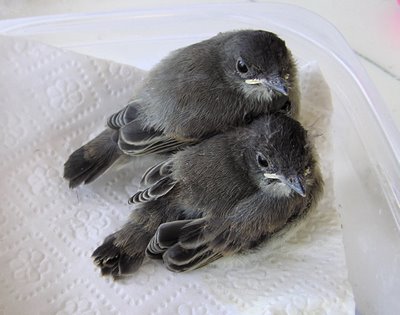 Avis, top, and Luther, bottom. Avis is bigger and has a longer tail. Luther still has a fuzz peruke.
Avis, top, and Luther, bottom. Avis is bigger and has a longer tail. Luther still has a fuzz peruke.June 16 was fledging day, Day 18 for the two homeless phoebes. On the evening of the 15th, we all worked together to put up the 15 x 17' nylon screen tent that serves as a halfway house for my orphaned songbirds. I could never build a flight cage this nice for $100. It's just what the bird doctor ordered.
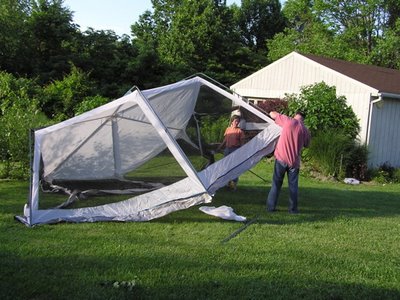 Meant for dining out in mosquito country, it folds up and stays in storage until it's needed. I got it at Campmor.com. Whatta deal!
Meant for dining out in mosquito country, it folds up and stays in storage until it's needed. I got it at Campmor.com. Whatta deal!The main virtues of this tent are that it's nice and roomy, and the birds can't harm their feathers on its soft mesh. Birds should never be kept in wire, though they frequently are. Since it's so flimsy, though, they can't be safely left in it overnight. So I bring them in before dusk to sleep in a pet carrier, in safety. When they get older, nearer the age where they'll be thinking about capturing their own flying insects, I'll put a lamp in it overnight to lure moths inside, and give them something to work on during the day.
Avis fledged first, flying strongly across the tent, back and forth, clinging to the walls. By golly, she's looking like a phoebe in this shot.
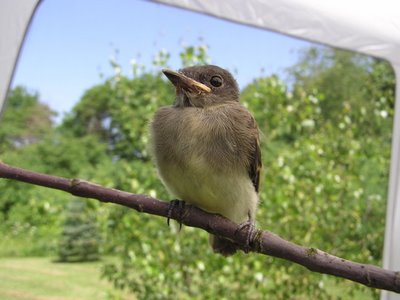 She's perched now on an ash branch that I drove into the ground, and seems content to stay there and be fed. Luther just fledged around 1 pm.
She's perched now on an ash branch that I drove into the ground, and seems content to stay there and be fed. Luther just fledged around 1 pm.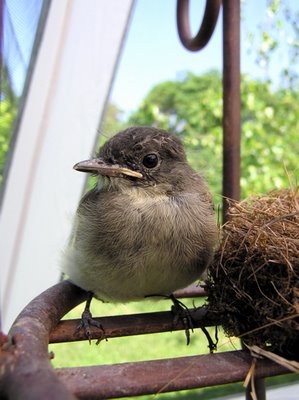 He's less adventuresome and perhaps a day behind Avis in development. And very sweet. By the way, the sexes and names have been arbitrarily assigned by Phoebe. No way to tell at this age.
He's less adventuresome and perhaps a day behind Avis in development. And very sweet. By the way, the sexes and names have been arbitrarily assigned by Phoebe. No way to tell at this age.A host of physical and psychological changes accompany the moment of fledging. The bird's droppings, formerly neatly contained the mucous membrane called a fecal sac, become looser and more frequent. It ceases to wiggle its tail and back up with the elaborate display that alerts its parents that it's about to void. Why bother, when there's no longer a nest to keep clean?
The bird becomes more alert, and takes more notice of its surroundings. New vocalizations emerge--in the phoebe's case, a dry chidick!
Most frustrating for me, the birds cease gaping for food. This happened with the chimney swifts I raised two summers ago. It's a kind of peri-fledging anorexia that doubtless helps them lose weight for better flight. But it's darned inconvenient, and worrisome. I have to pry their little bills open to put crickets and mealworms in, followed with a chaser of water so they don't get dehydrated. I'm praying that once they really start flying, this nonsense (which doubtless makes perfect evolutionary sense) will cease. It's clear to me that there's nothing wrong with them; they're bright and healthy and active, preening and flying. They just aren't interested in food, at least not from me. It will be another 18 days before they're able to catch their own food. I'm in the hoosegow until July 1. If I'll be gone more than a couple of hours, I have to pack them into a pet carrier and take them, their mealworms and crickets, along. It's a bore. Think about going to a softball game out in the hot sun and having to have live birds with you. Grocery store. Bank. Movie. Bike ride, pool. Whatever. No matter what you're doing, you have to shuttle them along with you (no leaving them in the car!) and you must stop every hour or so and cram crickets down two birds' throats. It takes a kind of dedication and constant preoccupation that's not everyone's cup of tea. I have to admit, it makes me a special kind of cranky.
So I make them work for their keep, posing for my paintings. And in the end, I'll have a hand-painted record of their development that is available nowhere else. I'll know something about phoebes, having been their momma.
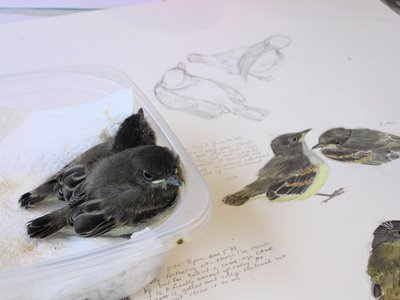 And there will be two more phoebes in the world. Worth it? Oh, yes.
And there will be two more phoebes in the world. Worth it? Oh, yes.






2 comments:
Hi Julie,
I noticed your last post was in 2006, so I don't know if you will get this comment or not. I have been blessed with 3 Phoebes! I don't know how old they are, as they arrived accidentally via someone's horse trailer, from 8 hours away! I couldn't believe they survived! Anyway, they fledged on May 12th, 2009, and they are now living in my bathroom. They never did stop gaping, but they are flying really well, and can even grab their food off a spoon in flight. I am guessing they will be ready to release soon. But I don't have a good way to do it gradually, as I have outdoor cats. If you happen to get this and have any advice for me, I would really love to hear from you! Thanks, Meg
Hi Meg,
Yes, through the miracle of blogs I did get your comment. Pretty much everything I know about releasing phoebes is here. I'm sorry to hear you have outdoor cats but very proud to hear you have been able to raise the birds to this point. They really, really need to be handed over to a rehabilitator who can work with them for soft release the way I did with my birds. It would really hurt to try it at your home and have your cats kill them. But they have had no opportunity to learn vigilance against predators, and little opportunity to gain strength on the wing. A bathroom isn't the great outdoors, and they have much to learn before being turned loose.
It always helps in these situations to give your state and location. I would recommend finding a songbird rehabilitator in your area using Google or:
The best websites for rehabilitator listings are:
http://www.tc.umn.edu/~devo0028/contact.htm
http://www.wildliferehabber.com/
National Wildlife Rehabilitators Association (NWRA) http://www.nwrawildlife.org/page.asp?ID=214
Other Sources For Locating Wildlife Rehabilitators:
Your state game department, which issues permits to rehabilitators. Many now have current listings of state permitted wildlife rehabbers and wildlife rehabilitation facilities on their websites. For example, in Virginia, the link is http://www.dgif.virginia.gov/wildlife/injured/rehabilitators.asp
Veterinary clinics.
Animal control agency and humane shelters.
The International Wildlife Rehabilitation Council (IWRC) claims to have a link on their website to a publicly-available listing of rehabilitators, but there is none. They can be contacted at: 408-271-2685 (San Jose, CA) or emailed at office@iwrc-online.org
Good luck. Further questions: julieatjuliezickefoosedotcom.
Post a Comment